|
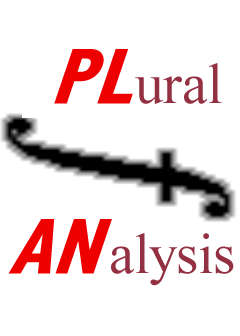
visit
|
GRAPHS &
MODELS PSY
Author : Zenon Kelper - first ed. 98/09/14
|

visit
|


 THE OPENING SPLIT OF A PSYCHOLOGICAL
MODEL
THE OPENING SPLIT OF A PSYCHOLOGICAL
MODEL
Though it started from a Thermodynamics
 ,
Psychoanalysis formulating can begin with a Psychology - for instance,
a Palo Alto model of the Psychological Communication gives
an easy insight on the first logic of Psychoanalysis.
,
Psychoanalysis formulating can begin with a Psychology - for instance,
a Palo Alto model of the Psychological Communication gives
an easy insight on the first logic of Psychoanalysis.

|

Schema 'X' : Logic of the Psychological Communication (Palo
Alto)

|
|
goto
all
graphs
goto
main
graphs

|
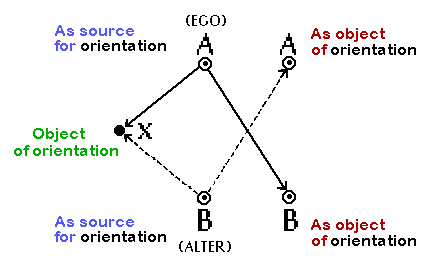
|
see
ecology
schema

|
|

"SCHEMA X" - comment: when two persons are
communicating, they share
an objective context (Object of orientation) while each one
is
a source of orientation towards the other as well as an object
of orientation for the other.
This constitutes the psychological being's first
split.

|
|

ABSTRACTED
PSYCHOLOGICAL
MODEL

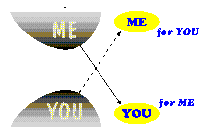
|
 In its abstracted
form (left) the model X let see the particularity of In its abstracted
form (left) the model X let see the particularity of
what can be called a true Psychological Model - for Psychoanalysis
differs there.
Popular psychoanalysis has already well informed
with the idea of an Oedipus Complex
which can make a pattern for some adult life
Men and women (right) are seeking for love,
while their quest for that object of orientation
is assisted by parental figures
(e.g. the Wife's Father Image that the Husband supports
and the Husband's Mother Image that the Wife supports):
 Thus, as
the parental model figure shows, the Me for you is much more something
of You than a 'real' part of me . To some extent, the me
is exclusively related to some instance which is all together an Other,
an Absolute You (see below). Thus, as
the parental model figure shows, the Me for you is much more something
of You than a 'real' part of me . To some extent, the me
is exclusively related to some instance which is all together an Other,
an Absolute You (see below).
|
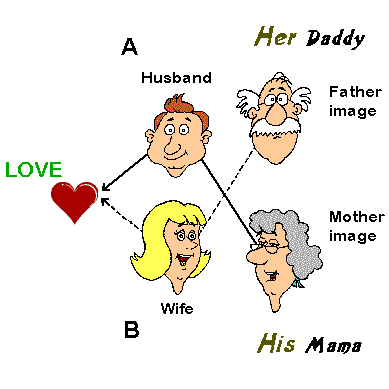
|
 THE ABSOLUTE LIMIT OF THE PSYCHOLOGICAL
MODEL
THE ABSOLUTE LIMIT OF THE PSYCHOLOGICAL
MODEL
 Many ways
alude, or represent this Absolute, which has made a perceptions for
many mystics and a cause or philosophy. It is illustrated in my sites as
a political issue
Many ways
alude, or represent this Absolute, which has made a perceptions for
many mystics and a cause or philosophy. It is illustrated in my sites as
a political issue
 , a linguistic issue
, a linguistic issue
 , a sociological factor for Genetics
, a sociological factor for Genetics
 , and a function in a Structural
system
, and a function in a Structural
system
 . These representations may not be easy
to understand from a Psychological point of view alone. The imaginary me
for you leads an infinite multiplication
. These representations may not be easy
to understand from a Psychological point of view alone. The imaginary me
for you leads an infinite multiplication
 (called Metonyme in Linguistics
(called Metonyme in Linguistics
 ) which is taken into account in
the Psychoanalytical point of view. This is where the distinction between
Psychology and Psychoanalysis begins :
) which is taken into account in
the Psychoanalytical point of view. This is where the distinction between
Psychology and Psychoanalysis begins :

|

THE DISTINCTION
OF PSYCHOANALYSIS
 Psychoanalysis
is a meta Psychology - that means that it is a 'psychology of psychology'
(aka a plural analysis which has been called and painted in
Lacan's case, by his friend Salvador Dali: critic paranoia Psychoanalysis
is a meta Psychology - that means that it is a 'psychology of psychology'
(aka a plural analysis which has been called and painted in
Lacan's case, by his friend Salvador Dali: critic paranoia
 ). In other words, Psychoanalysis considers
that any true psychology (with its absolutization) is
imaginary, in comparision with a real psychology which is tends
to look like a sociology (with its
pluralism). ). In other words, Psychoanalysis considers
that any true psychology (with its absolutization) is
imaginary, in comparision with a real psychology which is tends
to look like a sociology (with its
pluralism).
 Such 'reflection'
on one's own thinking process is not rare - as it is also shown in History
- History of Mentalities Such 'reflection'
on one's own thinking process is not rare - as it is also shown in History
- History of Mentalities
 ,
Mnemohistory ,
Mnemohistory
 , etc... However it is specially advanced
in the case of Psychoanalysis which began to present sets of formula representing
the work of Psyche (Psyche meaning mirror in ancient
Greek). , etc... However it is specially advanced
in the case of Psychoanalysis which began to present sets of formula representing
the work of Psyche (Psyche meaning mirror in ancient
Greek).
The Psychoanalyst J.Lacan intended to render the Absolute instance
amongst the components of the above Model 'X' (Psychological Model).
The schema below that I proposed in 1989
(PSO) shows the reasoning which leads to
Lacan Model 'L'
 . There one sees the very You
(Alter, or the Wife for the Husband in schemas above)
of the Psychological communication, being assumed as the Absolute Other (as
'A' in the schema below). Yet, most important is that as a result of this
assumption, the former 'as' figures (re. above: as object,
father image, mother image, etc...) acquire a status of 'representants'
- comparable with the grain or the surface of the mirror where an infant
realizes the production of his or her image (this is known as
Mirror Stage). . There one sees the very You
(Alter, or the Wife for the Husband in schemas above)
of the Psychological communication, being assumed as the Absolute Other (as
'A' in the schema below). Yet, most important is that as a result of this
assumption, the former 'as' figures (re. above: as object,
father image, mother image, etc...) acquire a status of 'representants'
- comparable with the grain or the surface of the mirror where an infant
realizes the production of his or her image (this is known as
Mirror Stage).
|
Constitution of the Imaginary Plan
and Social Reflexion
So
divided (re: split
 model 'X'), the
being conceives a new path towards model 'X'), the
being conceives a new path towards
his vis-a-vis: turning the 'as object' into
grain of
mirror
(seeming,
memes)
he gazes through a mirror-screen of the
"object-as" relationships ( a-a' ), towards his Ideal image
( I ) :
|
|
goto
all
graphs
goto
main
graphs
|
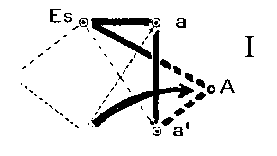
|
compare
Horizontal
mirroring
as psycho
and/or
as ecolo
|
|

"SCHEMA XL" - comment:
The "as object" ego/alter constitutes a primary network
(a-a' illustrated by Freud as the ego intererlationship
 ) - e.g. the structure that one
perceives ) - e.g. the structure that one
perceives
through linguistics. This imaginary relation constitutes the interface that
mirrors a Subject. Beyond this screen an Ideal is refered,
from Plato and philosophy since.
Lacan attempted to identify at this place, the unconscious or the paranoiac
Other
 , ,
in his progressist yet still resistant development.

|
 NOTE: Considering the memes
(grains of mirror: a-a') coming in place of the former
parental figures (imagos) of the Oedipus Complex, the
fantasm of the so-called murder is explained - as well as its
correlative constitution of a Law which comes in place of the
objective reference of the world. Yet this Lacanian stage of the analysis
shows its resistance while its inability to represent the biological
(i.e. environmental) condition of life. NOTE: Considering the memes
(grains of mirror: a-a') coming in place of the former
parental figures (imagos) of the Oedipus Complex, the
fantasm of the so-called murder is explained - as well as its
correlative constitution of a Law which comes in place of the
objective reference of the world. Yet this Lacanian stage of the analysis
shows its resistance while its inability to represent the biological
(i.e. environmental) condition of life.
There follow the Psychoanalytical representation of the superego regime :

The multi-faced divinity and the supremacy of
the Law represents the Lacanian degree of Psychoanalysis. In order to reach
the next phase, with the virtual reality of Artificial Intelligence
(instead of the multi-faced divinity) supplying for
a commun relationship towards the Environment (instead of the
Law)  , we
must apply an analysis of the Resistance , we
must apply an analysis of the Resistance
 according to the Freudian method, as well
as improving the dynamism according to the Freudian method, as well
as improving the dynamism
 of Lacan's Model : of Lacan's Model :

|
 Lacan's "OPTICAL MODEL"
(1950) renders
Lacan's "OPTICAL MODEL"
(1950) renders
the elucidation of the paradox that a first psychological
approach of Communication intuitively sketches (Model 'X',
above).
It is in a remarkable intrigue in the History of Psychoanalysis - that I
have currently set in charge of a eminent scholar, while I may disclose it
during my life time
 - that J.Lacan exposed the arcane mechanism
of the Model 'X'. He took the example given by a child in an E.A.Poe's novel
for the analysis of the psychological Communication. The Purloined
Letter is the text where two entities play the game of imagining what
the other imagines of oneself. It is not only a good approach for the enigma
that Egyptology explores
- that J.Lacan exposed the arcane mechanism
of the Model 'X'. He took the example given by a child in an E.A.Poe's novel
for the analysis of the psychological Communication. The Purloined
Letter is the text where two entities play the game of imagining what
the other imagines of oneself. It is not only a good approach for the enigma
that Egyptology explores
 , in regards with the neibourghing of Israel,
when the secret hieroglyph of the Atoniam monotheism was the supposed
Letter stolen by an heretic and displayed for the Jews - it is also an excellent
demonstration of the regime of knowledge that Cybernetics imposes with its
thinking machines
, in regards with the neibourghing of Israel,
when the secret hieroglyph of the Atoniam monotheism was the supposed
Letter stolen by an heretic and displayed for the Jews - it is also an excellent
demonstration of the regime of knowledge that Cybernetics imposes with its
thinking machines
 .
.
Here is the metapsychological process of the me-for-you in slow analytic
motion

Three beingness (three You) emanate from the
analysis:
first one subjective, subject of the knowledge of
being thought (second one, AKA the you-for-me complement)
as a
reflexive known (third one, verb)
 This is where
the Psychoanalytic development of the Psychological Communication
(Model 'X') rallies a Sociology, thus allowing
Psychoanalysis to stand as a Science (as Freud understood the
necessity for his theory, when he addressed it before de Mass Psychology
This is where
the Psychoanalytic development of the Psychological Communication
(Model 'X') rallies a Sociology, thus allowing
Psychoanalysis to stand as a Science (as Freud understood the
necessity for his theory, when he addressed it before de Mass Psychology
 ) and consequently a science for
Ecology
) and consequently a science for
Ecology
 .
.
 The Social
Link consist of the special thread of connections
The Social
Link consist of the special thread of connections
 which joins the social figures
(as the parents in the example of the oedipus Complex)
and undergo a splitting which the above animated picture shows in a thrice
development of the You (the Other) that the ego addresses,
and that the static figure of the lacanian model shows in the effect
of refraction that the optical metaphore allows
which joins the social figures
(as the parents in the example of the oedipus Complex)
and undergo a splitting which the above animated picture shows in a thrice
development of the You (the Other) that the ego addresses,
and that the static figure of the lacanian model shows in the effect
of refraction that the optical metaphore allows
 .
.
 The blend
of Psychology and Sociology is there achieved (meeting Freud's requirement
for validating Psychoanalysis
The blend
of Psychology and Sociology is there achieved (meeting Freud's requirement
for validating Psychoanalysis
 ). It is known as being also the degree
that Plato required for validating his Republic, as reprsented in Lacan's
model
). It is known as being also the degree
that Plato required for validating his Republic, as reprsented in Lacan's
model
 . Metaphoricaly, this is when a mirror operates
as the door of the cave
. Metaphoricaly, this is when a mirror operates
as the door of the cave
 . It is
the foundation of an Economy since Reflection unveils its Production effect
. It is
the foundation of an Economy since Reflection unveils its Production effect
 .
.
 Seen as
Ideal in the Virtual Reality (beyond
the mirror), the
'Ego' becomes the
'Subject'
($)
Seen as
Ideal in the Virtual Reality (beyond
the mirror), the
'Ego' becomes the
'Subject'
($)
in the Lacanian Optical Model phase
Democracy:
|

Psychoanalytical Representation
of the Sociology of Democracy
according to William Théaux
In its static version... Phase 1.
Body on the left &
Psyche on the right, inside the elliptic system nervous (as initialy set by
Lacan)
|
|
goto
all
graphs

goto
main
graphs
|
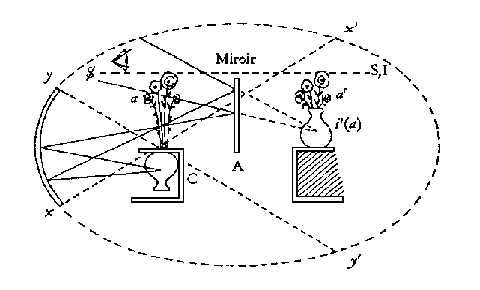
|
see
Republic
and
comparison

|
|

"OPTICAL MODEL (J.Lacan)"
- comment: This is identical to the above 'Schema XZ'. The
'object-as'
screen is
definitely a mirror
('A')
in Lacan's schema. Lacan also wrote the 'elusive Ego' as
$
(alias 'crossed-out-Subject')
that is mirrored as
'S,I'
(alias 'Ideal') by the composite (vase & flowers)
'C,a'.
This 'composite' equates
the above
Alter
- that is mirrored as i'(a)
or 'second You'. Lacan described the Transference
relationship as linking a' &
C; but was not able yet for a full
Ecological Model.

|
|
for
comparison: here is static version... Phase 2
called psychoanalysis or republic

where the eye has moved
180° towards I
(and the mirror truned horizontal 90°) |
 The same view had
been drawn by Freud in his MODEL OF THE CROWD (1920) :
The same view had
been drawn by Freud in his MODEL OF THE CROWD (1920) :
(notations in red and
blue added to show its relation to the parallel
Ecological Model)
|

Minimal Social Unit (3 egos/Me)
in the Social Psychoanalytical Model

|
|
goto
all
graphs

goto
main
graphs
|

|
see
politics
see
Lacan's
adding

|
|

"Model of the Crowd - S.Freud,
1921" - comment: Freud's Model for a Collective Psychology
is also identical to the above: its displays three (horizontal) levels which
can be compare
in the Lacanian Optical Model, with the 'Subject', the 'bunch', and the 'vase'.
On the right side of the schema Freud located the collective representant.
Further details and
comparison can be found in the historical
roots of this system,
supporting its validity as an Ecological
Model.

|
 NOTE: The important
step in the psychoanalytical field, which is displayed by this page is covered
in Theaux's bibliography. Especially the connection between Freud and Lacan's
Models (with psychology too) is described in
PSO (Lapreflexion) in French - it is also
commented in English in video lectures as
Psycho-analysis and Ecology.
NOTE: The important
step in the psychoanalytical field, which is displayed by this page is covered
in Theaux's bibliography. Especially the connection between Freud and Lacan's
Models (with psychology too) is described in
PSO (Lapreflexion) in French - it is also
commented in English in video lectures as
Psycho-analysis and Ecology.

END OF THE PAGE
FOOT PAGE
EXCHANGE IDEAS, IMPROVE
KNOWLEDGE
In association with the present
www.akhnaton.net
CYBEK and www.dnafoundation.com offer
Registration to a
Mailing
List -
free
subscription
Where you can send and receive messages to and from the readers.
It also kep you informed with the updates of the sites
Membership access
area -
one
time $15 fee
Where you can purchase and download e-books &
e-documents
You can also follow the e-book THE VEIL in progress,
get in contact with Z.Kelper and other
services
All transactions are secured
|
To send an email at Zenon Kelper

|
HOME

|
|
MAP of site

|
Comprehensive URLs List

|
MOST visited

|
DNAge

|
|
Membership

|
|
|
© William Theaux 1949-1999
![]()
![]()
![]() ,
Psychoanalysis formulating can begin with a Psychology - for instance,
a Palo Alto model of the Psychological Communication gives
an easy insight on the first logic of Psychoanalysis.
,
Psychoanalysis formulating can begin with a Psychology - for instance,
a Palo Alto model of the Psychological Communication gives
an easy insight on the first logic of Psychoanalysis.

![]() THE ABSOLUTE LIMIT OF THE PSYCHOLOGICAL
MODEL
THE ABSOLUTE LIMIT OF THE PSYCHOLOGICAL
MODEL
![]() Many ways
alude, or represent this Absolute, which has made a perceptions for
many mystics and a cause or philosophy. It is illustrated in my sites as
a political issue
Many ways
alude, or represent this Absolute, which has made a perceptions for
many mystics and a cause or philosophy. It is illustrated in my sites as
a political issue
![]() , a linguistic issue
, a linguistic issue
![]() , a sociological factor for Genetics
, a sociological factor for Genetics
![]() , and a function in a Structural
system
, and a function in a Structural
system
![]() . These representations may not be easy
to understand from a Psychological point of view alone. The imaginary me
for you leads an infinite multiplication
. These representations may not be easy
to understand from a Psychological point of view alone. The imaginary me
for you leads an infinite multiplication
![]() (called Metonyme in Linguistics
(called Metonyme in Linguistics
![]() ) which is taken into account in
the Psychoanalytical point of view. This is where the distinction between
Psychology and Psychoanalysis begins :
) which is taken into account in
the Psychoanalytical point of view. This is where the distinction between
Psychology and Psychoanalysis begins :
![]()
![]() Lacan's "OPTICAL MODEL"
(1950) renders
Lacan's "OPTICAL MODEL"
(1950) renders
![]() - that J.Lacan exposed the arcane mechanism
of the Model 'X'. He took the example given by a child in an E.A.Poe's novel
for the analysis of the psychological Communication. The Purloined
Letter is the text where two entities play the game of imagining what
the other imagines of oneself. It is not only a good approach for the enigma
that Egyptology explores
- that J.Lacan exposed the arcane mechanism
of the Model 'X'. He took the example given by a child in an E.A.Poe's novel
for the analysis of the psychological Communication. The Purloined
Letter is the text where two entities play the game of imagining what
the other imagines of oneself. It is not only a good approach for the enigma
that Egyptology explores
![]() , in regards with the neibourghing of Israel,
when the secret hieroglyph of the Atoniam monotheism was the supposed
Letter stolen by an heretic and displayed for the Jews - it is also an excellent
demonstration of the regime of knowledge that Cybernetics imposes with its
thinking machines
, in regards with the neibourghing of Israel,
when the secret hieroglyph of the Atoniam monotheism was the supposed
Letter stolen by an heretic and displayed for the Jews - it is also an excellent
demonstration of the regime of knowledge that Cybernetics imposes with its
thinking machines
![]() .
.
![]() This is where
the Psychoanalytic development of the Psychological Communication
(Model 'X') rallies a Sociology, thus allowing
Psychoanalysis to stand as a Science (as Freud understood the
necessity for his theory, when he addressed it before de Mass Psychology
This is where
the Psychoanalytic development of the Psychological Communication
(Model 'X') rallies a Sociology, thus allowing
Psychoanalysis to stand as a Science (as Freud understood the
necessity for his theory, when he addressed it before de Mass Psychology
![]() ) and consequently a science for
Ecology
) and consequently a science for
Ecology
![]() .
.![]() The Social
Link consist of the special thread of connections
The Social
Link consist of the special thread of connections
![]() which joins the social figures
(as the parents in the example of the oedipus Complex)
and undergo a splitting which the above animated picture shows in a thrice
development of the You (the Other) that the ego addresses,
and that the static figure of the lacanian model shows in the effect
of refraction that the optical metaphore allows
which joins the social figures
(as the parents in the example of the oedipus Complex)
and undergo a splitting which the above animated picture shows in a thrice
development of the You (the Other) that the ego addresses,
and that the static figure of the lacanian model shows in the effect
of refraction that the optical metaphore allows
![]() .
.
![]() The blend
of Psychology and Sociology is there achieved (meeting Freud's requirement
for validating Psychoanalysis
The blend
of Psychology and Sociology is there achieved (meeting Freud's requirement
for validating Psychoanalysis
![]() ). It is known as being also the degree
that Plato required for validating his Republic, as reprsented in Lacan's
model
). It is known as being also the degree
that Plato required for validating his Republic, as reprsented in Lacan's
model
![]() . Metaphoricaly, this is when a mirror operates
as the door of the cave
. Metaphoricaly, this is when a mirror operates
as the door of the cave
![]() . It is
the foundation of an Economy since Reflection unveils its Production effect
. It is
the foundation of an Economy since Reflection unveils its Production effect
![]() .
.
![]() Seen as
Ideal in the Virtual Reality (beyond
the mirror), the
'Ego' becomes the
'Subject'
($)
Seen as
Ideal in the Virtual Reality (beyond
the mirror), the
'Ego' becomes the
'Subject'
($)
![]() The same view had
been drawn by Freud in his MODEL OF THE CROWD (1920) :
The same view had
been drawn by Freud in his MODEL OF THE CROWD (1920) :![]() NOTE: The important
step in the psychoanalytical field, which is displayed by this page is covered
in Theaux's bibliography. Especially the connection between Freud and Lacan's
Models (with psychology too) is described in
PSO (Lapreflexion) in French - it is also
commented in English in video lectures as
Psycho-analysis and Ecology.
NOTE: The important
step in the psychoanalytical field, which is displayed by this page is covered
in Theaux's bibliography. Especially the connection between Freud and Lacan's
Models (with psychology too) is described in
PSO (Lapreflexion) in French - it is also
commented in English in video lectures as
Psycho-analysis and Ecology.
![]()